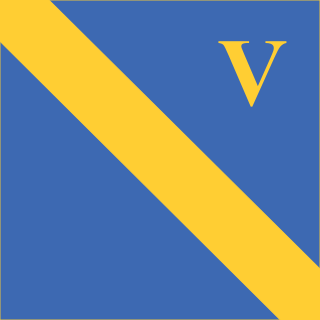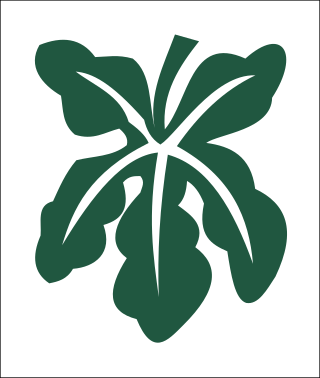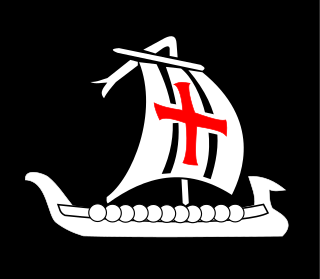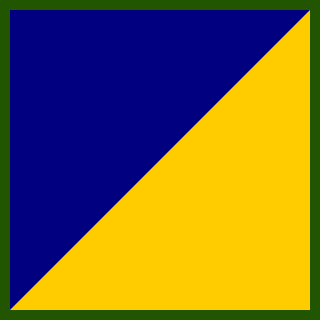
I Corps was an army corps in existence as an active formation in the British Army for most of the 80 years from its creation in the First World War until the end of the Cold War, longer than any other corps. It had a short-lived precursor during the Waterloo Campaign. It served as the operational component of the British Army of the Rhine during the Cold War, and was tasked with defending West Germany.

IV Corps was a corps-sized formation of the British Army, formed in both the First World War and the Second World War. During the First World War the corps served on the Western Front throughout its existence. During the Second World War it served in Norway and Britain until it was transferred to India, which was threatened with attack after Japan entered the war.

The 5th Infantry Division was a regular army infantry division of the British Army. It was established by Arthur Wellesley, 1st Duke of Wellington for service in the Peninsular War, as part of the Anglo-Portuguese Army, and was active for most of the period since, including the First World War and the Second World War and was disbanded soon after. The division was reformed in 1995 as an administrative division covering Wales and the English regions of West Midlands, East Midlands and East. Its headquarters were in Shrewsbury. It was disbanded on 1 April 2012.

The II Corps was an army corps of the British Army formed in both the First World War and the Second World War. There had also been a short-lived II Corps during the Waterloo Campaign.

III Corps was an army corps of the British Army formed in both the First World War and the Second World War.

The 79th Armoured Division was a specialist armoured division of the British Army created during the Second World War. The division was created as part of the preparations for the Normandy invasion on 6 June 1944, D-Day.

The City of London Yeomanry (Rough Riders) was a yeomanry regiment of the British Territorial Army, formed in 1901 from veterans of the Second Boer War. In the First World War it served dismounted in the Gallipoli Campaign but reverted to the mounted role in the Senussi campaign, at Salonika and in Palestine. It ended the war as a machine gun unit on the Western Front. In the interwar years it was reduced to a battery in a composite Royal Horse Artillery unit in London, but in the period of rearmament before the Second World War it was expanded into a full regiment of light anti-aircraft artillery. It served in this role during The Blitz and later in the Tunisian and Italian campaigns. Postwar it became an armoured regiment. It amalgamated with the Inns of Court Regiment to form the Inns of Court & City Yeomanry in 1961. The lineage is maintained by 68 (Inns of Court & City Yeomanry) Signal Squadron, part of 71 (Yeomanry) Signal Regiment.

The Norfolk Yeomanry was a volunteer cavalry (Yeomanry) regiment of Britain's Territorial Army accepted onto the establishment of the British Army in 1794. After seeing action in the Second Boer War, it served dismounted at Gallipoli, in Palestine and on the Western Front during the First World War. Between the wars it converted to the Royal Artillery (TA), and served as an anti-tank regiment in France, the Western Desert, Italy and North West Europe during the Second World War. After the war it served as a TA air defence unit and then as an Army Air Corps unit.

V Corps was an army corps of the British Army that saw service in both the First and the Second World Wars. It was first organised in February 1915 and fought through the First World War on the Western front. It was recreated in June 1940, during the Second World War and was substantially reorganised in 1942 for participation in Operation Torch. It fought through the Tunisia Campaign and later the Italian Campaign.

The Queen's Own Oxfordshire Hussars (QOOH) was a Yeomanry Cavalry regiment of the British Army's auxiliary forces, formed in 1798. It saw service in the Second Boer War with 40 and 59 Companies of the Imperial Yeomanry and was the first Yeomanry regiment to serve in Belgium and France during the Great War. After almost four years of Trench warfare on the Western Front, where cavalry had been superfluous, the QOOH led the advance during the Allies' victorious Hundred Days Offensive in 1918. In 1922, the QOOHt became part of the Royal Artillery and during World War II it served as anti-tank gunners at Singapore and in North West Europe. After a series of postwar mergers and changes of role, the regiment's lineage is maintained by 142 Vehicle Squadron, Royal Logistic Corps.

The Westmorland and Cumberland Yeomanry was a Yeomanry Cavalry regiment of the British Army with its origins in 1798. The regiment provided troops for the Imperial Yeomanry during the Second Boer War and served on the Western Front in the First World War, latterly as infantry. The regiment converted to artillery in 1920 and served as such in the early years of the Second World War, before becoming part of the Chindits in Burma. Postwar it served as a gunner regiment until 1971 when the title disappeared.

The Pembroke Yeomanry was an auxiliary regiment of the British Army dating back to 1794. It saw active service in the French Revolutionary War, the Second Boer War, World War I and World War II. Its lineage is maintained by 224 Transport Squadron, part of 157 (Welsh) Regiment RLC in the Army Reserve.

The Hertfordshire Yeomanry was a Yeomanry Cavalry regiment of the British Army that could trace its formation to the late 18th century. First seeing mounted service in the Second Boer War and World War I, it subsequently converted to artillery. Three regiments saw service in World War II, one of which was captured at the fall of Singapore. It continued through various postwar amalgamations and its lineage was maintained by 201 Battery, 100th (Yeomanry) Regiment Royal Artillery until that unit was placed in suspended animation in 2014.
The Surrey Yeomanry was a unit of the British Army first formed as volunteer cavalry in 1794. It was reformed in 1901 and saw varied service in the First World War. During the interwar period, it converted to artillery and during the Second World War one of its regiments distinguished itself during the retreat to Dunkirk, saw action during the Second Battle of El Alamein, and also saw service in Sicily and Italy. Its other regiment served in East Africa, the Siege of Tobruk, and in Iraq and Persia. The regiment's lineage is maintained today by 2 Field Troop, 579 Field Squadron (EOD), part of 101 (London) Engineer Regiment (Volunteers).

XII Corps was an army corps of the British Army that fought in the First and Second World Wars. In the First World War, it formed part of the British Salonika Force on the Macedonian front. In the Second World War, it formed part of the British Second Army during Operation Overlord and the subsequent North-West Europe Campaign of 1944-46.
59th Army Group Royal Artillery was an artillery formation of the British Army in World War II. Having operated in the North West Europe theatre in late 1944, it was switched to India to command artillery units preparing for the liberation of South-East Asia.

The 1st Devonshire Artillery Volunteers and its successor units served in the British Army's Reserve Forces from 1859 to 1961. During World War I it carried out garrison duty in British India but went on to see active service in the Third Anglo-Afghan War. Converting to an air defence role before World War II its units participated in the Norwegian campaign and the Dunkirk evacuation, the Battle of Britain and then the campaigns in North Africa, Italy, and Burma

The 191st Field Regiment was a unit of Britain's Royal Artillery (RA) formed during World War II. Created around experienced drafts from existing Territorial Army units, it trained as mobile artillery with an armoured division. Later it served through the campaign in North West Europe, supporting varied formations such as the Royal Marine Commandos, Royal Armoured Corps and Polish troops operating under First Canadian Army.

The 1st Glamorganshire Artillery Volunteers was formed in 1859 in response to a French invasion threat. Raised as a coast artillery unit, it later became part of the Royal Field Artillery in the Territorial Force and served during both World Wars until amalgamated in 1961.

8th Army Group Royal Artillery was a brigade-sized formation organised by Britain's Royal Artillery (RA) during World War II to command medium and heavy guns. It served in the campaign in North West Europe, participating in the battles in the Orne valley and the bocage south of Caumont before the breakout from the Normandy beachhead, operations to close up to the Maas, and the assault crossing of the Rhine.



















